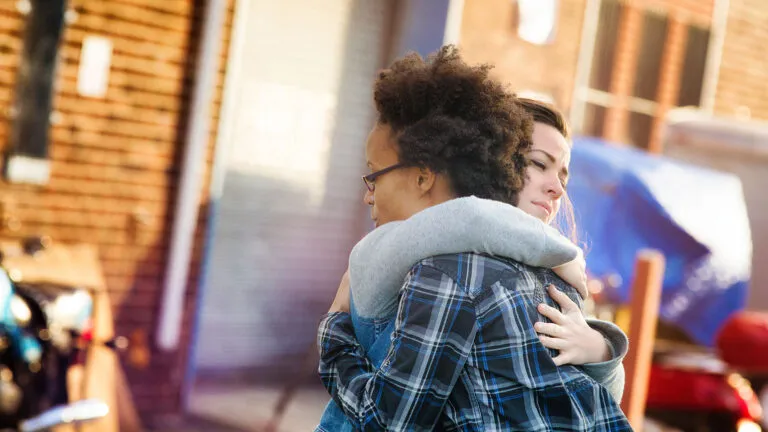The candles we make at Wax Buffalo are imperfect—“beautifully imperfect,” as we like to say. Each one is unique, hand-poured with unbleached cotton wicks and pure soy wax. It’s a small business I started, and everyone who works here comes into the studio at odd hours, whatever works best for them—some at 5 a.m., some at midnight—so they can be home with their kids, spouses, cats, dogs at prime times.
I first fell in love with candles on visits to my grandmother Ferne’s house in Lincoln. At night, candlelight flickered off the book-lined walls, the place smelling of cinnamon, no matter the season. During the day, she’d take me to a café in the historic Haymarket district and we’d sip tea out of china cups and eat cucumber sandwiches, like characters in an English novel. Then we would buy handmade candles at her favorite shop.
I poured my first candle at the age of 14, using the candlemaking kit that Ferne had given me, watching the wax harden as the candle cooled, the sweet fragrance filling the air. I gave the finished product to my grandmother for Christmas. She loved Christmas, and she loved that candle I’d made for her.
That first candle was imperfect. Beautifully imperfect, though I didn’t see the beauty in imperfection then. For years, I strove for perfection in all I did, working for perfect grades in school, getting the perfect job, posting the perfect photos on social media, moving into the perfect home, all the while maintaining a perfect relationship with God.
I married Jon—who seemed pretty close to ideal—and we bought a lovely house outside Lincoln with stunning lake views. I ended up hosting a documentary television show, traveling all over the world to find just the right shots, just the right cuts of a film to air. Jon worked for the same program. When I became pregnant with our first child, I could imagine how I would announce her birth, posting pictures of her on Facebook and Instagram and writing a blog about how beautiful the experience had been.
That summer of 2011, I remember driving through the cornfields on our way home and saying to Jon, “Could our lives be any more spectacular?” We had everything we wanted.
Our daughter, Navy, came into this world at 10:59 on an early August night. The nurses handed her to me, crying, and she snuggled close to my heart, falling asleep in my arms. It was love at first sight. But I saw the tear in her upper lip, as if it had been split in half. She was born with an extreme unilateral cleft lip and palate.
Most expectant parents know beforehand if their child has a cleft lip or palate. It usually shows up on an ultrasound, but it didn’t with Navy. We didn’t know it was coming. Somehow I blamed myself, as if it were my fault, something I had done wrong during the pregnancy. Had I already failed as a new mother?
Navy was admitted to the NICU that night. Jon and I were alone in that little hospital room, shocked and too scared to pray. The next morning, Ferne was one of the first people to visit, a light in our darkness. She loved Navy instantly, as Jon and I did, and was one of the first people to hold her, rocking her gently as she snored her tiny cleft palate snore. I wondered where God was in all of this, but Ferne had no doubt.
“Honey,” she said, wrapping me in a hug. “You did nothing wrong. God is with you.”
Ferne knew something about struggle. She’d taken care of her blind and bedridden husband for more than 19 years, lovingly tending him day and night. She’d had two bouts with breast cancer. That second time around, Jon and I had been living in Chicago and we moved to Lincoln to help care for her while she underwent treatments. We figured we’d cook for her, clean her gutters, take care of the house, then go back to Chicago when she was feeling better. Instead, we decided to stay.
The doctors said we had to wait four months before they could perform surgery on our baby. During that time, we needed to stretch Navy’s lips and nose with our hands, massaging them to lessen the gap in the cleft palate, giving the surgeon more flesh to work with. Four months of waiting, coaxing Navy to sleep, trying to get her to eat. Four months of doctors’ and hospital visits, more scans, more doubts.
We did not post pictures of Navy during those first few days. I didn’t know how to tell her story, how to explain what our precious daughter was going through. We asked for prayers, of course, but Jon and I were at our wits’ end. To make matters worse, the documentary television show we both worked for lost its funding and was canceled. I lost my job, Jon lost his job and we all lost our health insurance. He and I were weighted down with worry, and our marriage suffered.
The surgery for Navy was scheduled right before Christmas. It was as though we’d been going through our own version of Advent, waiting for months, seeking some glimmer of hope in our winterlike gloom.
That day in December, we drove to the hospital and I lifted Navy out of her car seat and held her close, afraid to give her up to the doctors’ and nurses’ care. I knew they would do their best, but she was so young, so tiny, so fragile.
After four hours of surgery, they brought us our baby, her cleft lip and palate repaired. She had new pouty lips, like every other little child. We were so grateful.
Our lives resumed their course. Jon got a new job. Our marriage righted, and we had another child—a boy, Satchel. I was up to my ears in diapers and baby food and strollers and picture books and silly songs and cartoons on TV. But my faith was shakier because of what we’d been through—the unpredictability of it made me feel as though the ax could fall at any moment. My posts on social media weren’t as exuberant as they’d once been. Nor was my joy in life. I leaned on my grandmother even more, wanting some of that bedrock faith of hers.
Then in the summer of 2014, life took a dark turn for my grandmother—though she adamantly refused to see it that way. The breast cancer came back. This time, though, Ferne refused treatment. “I’m ready,” she said. “Ready to go home.”
I resisted that prospect. I didn’t want to lose Ferne, the light of my life. I took the kids to be with her every Monday, and we’d have a picnic in her cinnamon-scented house, eating fried chicken and potato salad, laughing and telling old stories. Then one Monday, she wasn’t making a lot of sense, repeating herself and getting confused, this from a woman who was always sharp and sassy. The cancer, we later learned, had moved to her brain.
She went fast after that. Very fast. The funeral came all too soon, two days after Navy’s third birthday. My sweet Ferne’s light was spent. Gone forever.
Or was it? I found myself thinking about the candlemaking kit she had given me as a 14-year-old kid, the joy it had brought me. Exactly one month after I kissed Ferne goodbye, I began pouring candles again. The first one I made was cinnamon scented. I poured more, making them for friends. Because of Navy’s health, I’d become especially attuned to natural products, things that were safe for my children to be around. I used locally sourced soy wax and natural scents. Was there a way I could make candles for people beyond my group of friends? Could this be a new business for me, one that didn’t take me on the road for long periods, as my previous career had?
I did research and talked to friends and to people who were looking for work that would fit in around the demands of child-rearing. I found a space to rent, a light-filled studio that reminded me of the warehouse district my grandmother and I used to visit when I was young. Navy was old enough by then to be a help, putting stickers on jars and drawing pictures of candles when I visited clients. I felt confident in asking other moms to join us, knowing I could promise them a flexible work environment.
And so, Christmas of that year, Wax Buffalo was launched (Buffalo in tribute to the Midwest). Little by little, the business grew as we found more people who wanted our candles, more stores to offer them. We now have six people working for us, and our candles are sold in more than 60 boutiques across the country. I like to think they light up homes and spread their delicious fragrance from town to town, city to city.
I say to Jon now, as we drive through the snow-covered cornfields, “Aren’t we blessed? Isn’t life wonderful?”
Indeed, it is—beautifully imperfect. But it hasn’t turned out at all how I’d have predicted. It’s no script I would have written or produced. But then, it didn’t come from me at all. I think that’s what Ferne wanted me to understand. To trust the light of God, to bask in its glow, to know that it can transform a person from within.
For more inspiring stories, subscribe to Guideposts magazine.
![Wax Buffalo candle creator Alicia with her kids [from left]: Navy, Oxley and Satchel](https://stage.guideposts.org/wp-content/uploads/2018/11/alicia_reisinger_marquee-1024x576.jpg.webp)




